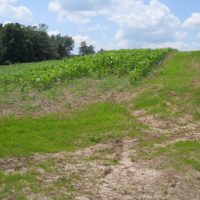Don’t let acidic soil kill your fun. People often misunderstand the problem with acidic soil. It’s not that things won’t grow in acidic soil or that what grows is not palatable to deer.
The problem (in very simple terms) with soil that tests below the recommended Ph level for a given plant is that acidic soil limits the plant’s ability to uptake and utilize nutrients. Therefore growth of the plant is slowed and maturity will come more slowly. Not ideal, but not a deal buster because we’re just growing stuff to feed deer. Let ‘er rip.
Yes, you can get good stands of clover to grow in low Ph (acidic) soil. I do it all the time because adjusting Ph takes years. I started at an average of 4.5 to 4.75 and only now after years of lime applications am I sneaking up on 5.5. Still a ways to go to get to 6, but like I said, don’t let that spoil your fun.
To keep this simple, apply as much lime as possible before planting. Guys will often say to try to get local co-ops to spread lime for you, I’ll tell you right now forget that. Your plots are too small and their equipment is too big, it’s too difficult to arrange and your ground will probably be too soft to do it in the spring anyway.
Instead, spread as much pelletized lime as you can in the early spring. Pelletized lime looks like fertilizer and spreads easily through a broadcast spreader. Lime does not wash away nor does it evaporate like fertilizer, so spread any time after the snow is gone. I spread lime in the early spring when there is nothing else that can be done because the ground is too wet. I use an ATV and a towable spreader.
On small plots like yours, clover is an excellent choice. It’s under-rated because I think to some guys it seems too easy. There is never a time when deer won’t eat clover if they can get it. It also is the most acidic tolerant of the common food plot crops. Plant a clover blend, don’t be fooled into anyone telling you X or Y clover as a single variety is “best”. To a deer, clover is clover, and a blend gives you the best chance at good performance in different weather and soil conditions.
Also, make sure you plant a norther-hardy, PERRENIAL clover. Many southern US blends contain only annual clovers that must be replanted every year. In the north, we want perrenial clovers because our short growing season and the clove up here doesn’t die in the heat as it does down south.
Get a thorough kill on your plots with glyphosate (roundup) before planting. I always kill twice, spray once on green weeds and then spray a second time before planting. Gly is a contact killer, it does not affect seed and it has no residual in the soil.
In our area, you must use a nurse crop on small plots. A nurse crop grows faster than teh clover so the deer browse the nurse crop rather than pulling out the clover. Clover without a nurse crop will be damaged by overbrowsing and the deer pull it out by the roots when it’s young, thinning the plot. A nurse crop limits this damage.
If possible, plant your clover in May or June or after August 1 if rains have been frequent. For a nurse crop for all summer clover, I use oats at about 100 pounds per acre.
If you need clover, our Mega Clover Plus blend is always in stock and I have oats as well.
Don’t rush your prep work in the spring. Wait for greenup, spray to kill, work the ground, spray again, and keep at it until you’re ready to plant. Seed bed prep is absolutely key, having a clean seed bed greatly limits problems down the road.
Best of luck. You’ll love it!
Grouse
